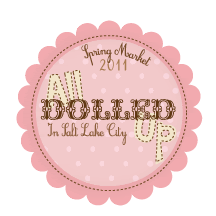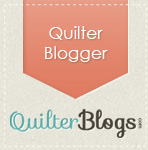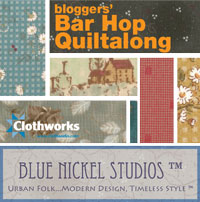Going Green has been trendy for a while now. Taking care of earth's resources has moved into public consciousness and into quilting. (Picture shown is Birch Organic circa 60 Beach Mod. I used it in my last book, Simply Charming Modern. I love the prints!)
In the interest of full disclosure, let me mention up front that I have 6 kids. I live near the mountains. I love my Suburban. Love. I remember when I was younger and we had vehicles that we held our breath and didn't get behind any trucks to slow down our momentum when driving up canyons. I don't want to worry about things like that any more.
I also love innovation, and I don't want anyone telling me what I have to buy or can or cannot have.
I have been intrigued, however, by all the organic materials that are flooding the market. It baffled my mind that cotton wasn't organic. I decided to find more about what makes something organic. I asked questions. I attended a lecture on the subject.
I learned that cotton isn't considered organic if certain pesticides are used when it is grown. Bamboo is considered superior to cotton because it grows faster, and I think there's something about nutrients in the soil that cotton takes and bamboo doesn't.
In fabric, the cotton has to be grown without the certain pesticides, and it has to be made using certain dyes that aren't harmful.
I've had my questions answered except for batting.
What batting is the most green?
Literally, the answer would be Quilter's Dream Batting's Dream Green batting because it is actually green.
It is green because it is made from recycled 2-liter bottles. It is a polyester batting. I have used it, and I like it. Is it the winner because it's recycled, or is it not because it's polyester?
Is it bamboo because it's "better" than cotton?
I love the drape of bamboo. I hear bugs don't like it. That's a good thing.
Is it organic cotton batting?
I didn't know this existed until this morning when I saw that Hobb's has an organic cotton batting, so I assume others may as well. I am curious why I haven't noticed these before. I love their 100% cotton with scrim -- I gotta have the poly scrim, so I don't pull it apart when I am quilting it.
Is it wool? Or does that bring up all sorts of animal issues?
I love wool batting! It quilts so beautifully--by hand and machine. It's washable.
Which do you vote for? Did I miss one?
I really want to know who the unofficial winner will be!













 Quilter Blogs & Store Search
Quilter Blogs & Store Search


















11 comments:
Bamboo batting uses a very toxic process to create it. It is a tough cellosis that takes many chemicals to break it down to make it soft.
Wool batting is wonderful to quilt and it has a beautiful drape, but it can shrink if not treated properly.
PB
My vote goes to wool! I love it but it is so expensive!! Great post...got me thinking...which doesn't happen often...hahah! Have a great day!
P
I am intrigued by the "exotic" types of batting that have been introduced to the market. Silk, bamboo, soy ... any new innovation could be a terrific alternative to cotton, polyester or wool.
There has been a tremendous amount of hype concerning bamboo (and bamboo combinations) batting. Any marketing that smacks of hyperbole instantly raises my suspicions.
There *are* a LOT of wonderful attributes to bamboo batting ... but beware, beware, beware. You do *not* know how it was processed. You could get that eco-friendly, organic batting that retains all those fantastic bamboo attributes that you want OR you could be getting a bamboo batting that hardly resembles what marketing has primed every quilter to expect.
An interesting article concerning the good/bad about processing bamboo can be read at http://www.awakenedaesthetic.com/2010/01/how-green-is-your-bamboo/ . I am not in any way affiliated with the site; I don't know if they have any biases one way or the other. I read the article and felt it was fairly well balanced and nicely presented pertinent facts.
Bottom line for me: I'll probably stick with cotton blends and/or polyester battings unless I come across some fantastic deals for other types. :-)
I'd vote wool too. I've never used it before, but since you say it quilts so nicely, I might to have to give it a try!
I fully understand your concerns as one who has been eating organic fruits, vegetables and cereals preferable grown locally since the late 80ties before it was trendy to do so. I do not use plastic bags except on very few occasions and I reuse the ones I do use multiple times because I too care about my children's future.
I use organic cotton fabrics whenever I can get my hands on them which sadly is very rare here. The batting question is a very, very complicated (and controversial) issue. Besides taking into consideration how the natural fibres are grown whether in soil or on the back of your sheep who also take up land and deliver waste products to the soil, you must also take into consideration the amount of water that is used not only to grow it but also later in the production of the batting, what fertiliser is used and the harvest method, the transportation of the material (and the other products needed for the manufacturing) and the process the raw product goes through before it ends up in your sewing room.
Recycling of plastic bottles is controversial too - should there be plastic bottles in the first place? and the production of them is not taken into account but seeing that they are there and takes hundreds of years to disappear leaving nasty stuff along the way if they go into land-fill it can be argued that the recycling process should have some credit given to it in advance when comparing with the so-called natural products.
I have been musing about this for a long time now too and as no batting is being made from produce grown near me (I live in Europe so no cotton, silk or bamboo on my doorstep) and as all the fabric I use for the whole patchwork/quilting process is imported from far away it is very hard for me to cast a vote here but taking all this into consideration I think I would vote for the recycled plastic bottles until we find an alternative to what they are designed for in the first place i.e. drinks.
Thanks for considering this in the first place and for writing about!
Can't I just use blankets or flannel sheets from the thrift store as batting and bypass the issue entirely? :-)
I am sorry, but I think cotton, bamboo, and wool are all organic. They are grown naturally. Where is the polyester plant? Everything else is just hype.
You raise and interesting question. I have read many things about bamboo batting that leads me to believe that it is not as environmentally sound as manufacturers wish us to believe. There is a huge amount of water used and wasted during the process that out weighs the fact that it comes from a renewable source.
I don't have an answer, but I sure would like to know the truth about all battings.
Looks like there isn't an easy answer, but then, I didn't expect there to be one. Thanks for adding to the conversation!
The "green" batting made of bottles is on my NOT list. The idea of plastic bottle IN my quilt is very unpleasant.
So much info is marketing "hype" that I am doubtful of any kind of batting and I only use all cotton or 80/20. It's getting hard to even purchase products with all the "hype" around each of them. Expense/cost is a real consideration.
I like the Dream Green batting. First of all I like that it is made from recycled 2-liter pop bottles because I recycle a lot of them myself. Second, it quilts great on the machine as well as quilts great by hand and it washes up very nice.
The carpet I put in my living room 2 years ago is also made from recycled 2-liter pop bottles (87% with 13% nylon). It looks great and has held up wonderful-very easy to clean also.
Post a Comment